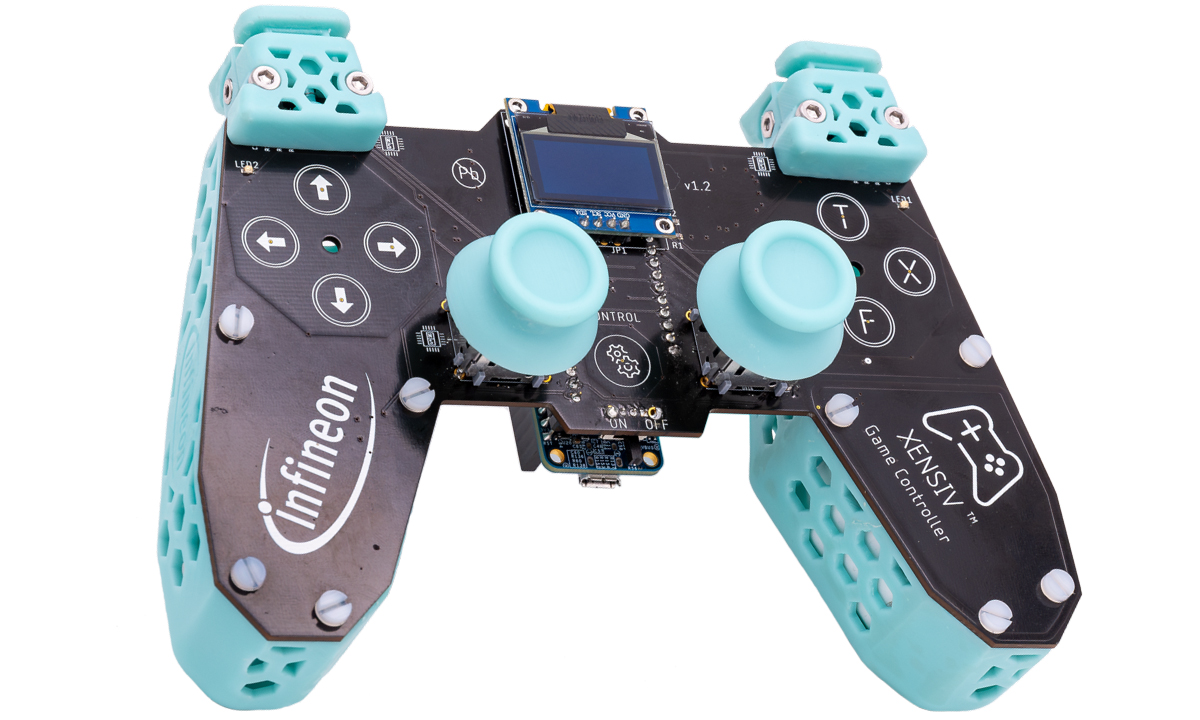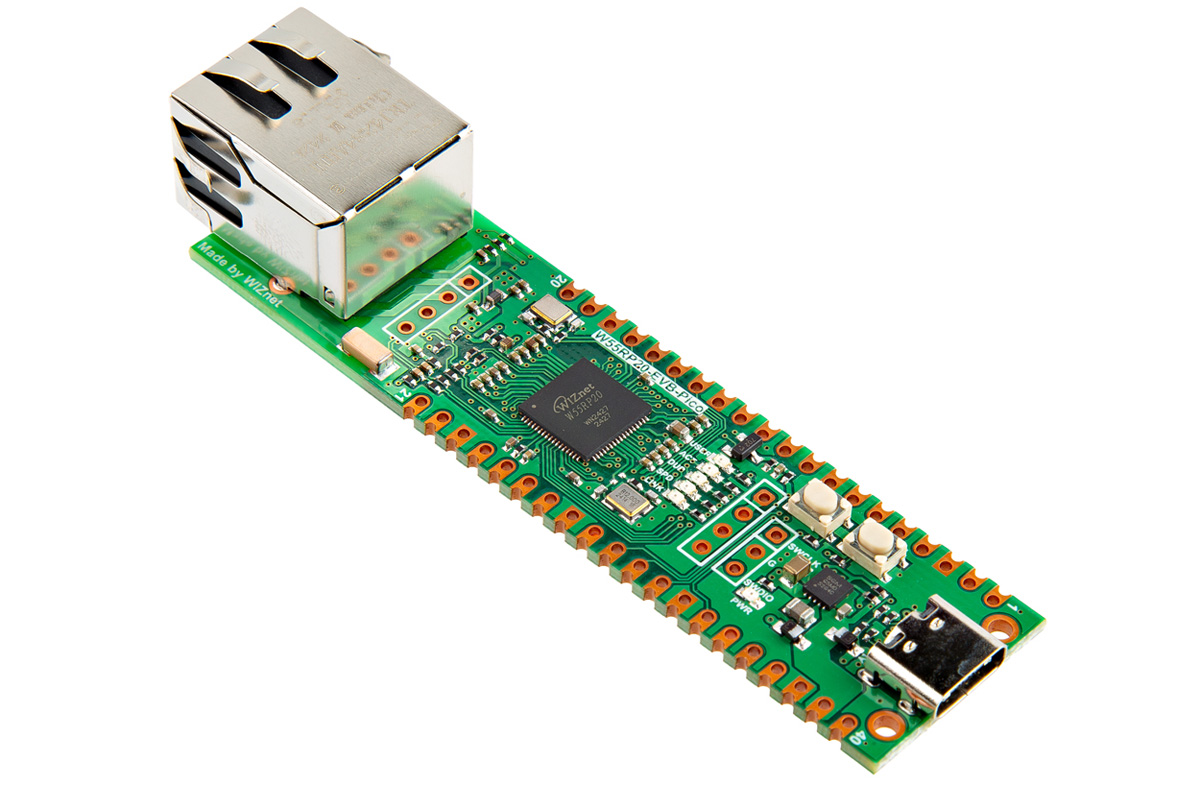Infineon Technologies XENSIV game controller is a reference design that integrates XENSIV magnetic position sensors for precise joystick control without sensor drift and XENSIV Hall switch triggers for reliable operation. The controller also features capacitive CAPSENSE buttons, CAPSENSE presence detection, and a SPIDER+ rumble driver. These components work together with the PSoC 6 BLE microcontroller to create a low-power, plug-and-play solution. The onboard display allows users to monitor joystick movements, connection status, configurations, and battery information. The controller connects to PCs or smartphones as a USB human interface device (HID) without requiring manual configuration or driver installation. It also supports Bluetooth Low Energy and uses capacitive presence detection to optimize battery life. The design includes a PSoC 6 debugger and supports customizable shields providing flexibility for software and hardware integration. Previously, we covered an Arduino Nano Matter-powered game controller that successfully ported Quake, a popular first-person shooter game. We’ve also […]
Wiznet W55RP20-EVB-Pico board features W55RP20 SiP with W5500 Ethernet controller and RP2040 MCU
Wiznet has recently released the W55RP20-EVB-Pico dev board, a compact board based around the W55RP20 SiP that fuses the Raspberry Pi RP2040 MCU and the W5500 Ethernet controller into a single IC, plus a 2MB flash chip for firmware storage. Just last month we wrote about W5100S-EVB-Pico2 and W5500-EVB-Pico2 dev boards, both the boards have a newer Raspberry Pi RP2350 MCU and external Ethernet controller (W5500 or W5100S). The RP2350 offers additional security features such as One Time Programmable (OTP) memory, secure boot, and Arm TrustZone technology, making it more suitable for secure applications. The W55RP20 on the other hand integrates a W5500 Ethernet controller and the RP2040 in a single SiP which is also pin-compatible with the Raspberry Pi Pico, making it easy to use existing Pico accessories and code examples. W55RP20-EVB-Pico dev board specifications: SiP– W55RP20 microcontroller MCU – Raspberry Pi RP2040 Core– Dual Cortex M0+ cores up […]
Firefly introduces Rockchip RK3576 SoM and All-in-One carrier board compatible with NVIDIA Jetson Orin Nano and Orin NX modules
Firefly has released a Rockchip RK3576 SoM and development board called the Core-3576JD4 Core Board with a SO-DIMM edge connector and the AIO-3576JD4 carrier board respectively. The core board or the SoM is built around an octa-core 64-bit processor with a Mali G52 MC3 GPU and a 6 TOPS NPU, so it can handle demanding AI tasks while maintaining low power consumption. The AIO-3576JD4 is a full-fledged carrier board with a wide range of on-board interfaces, like dual Gigabit Ethernet ports, MIPI-CSI, HDMI 2.1, USB 3.0, USB 2.0, USB Type-C, a Phoenix connector for serial, dual-row pin headers (SPI, I2C, Line in, and Line out), an M.2 socket for 5G, a mini PCIe for 4G LTE, an M.2 socket for WiFi 6/BT 5.2, and a third M.2 socket for SATA/PCIe NVMe SSD expansion. RK3576 AI SoM and dev board specification Core-3576JD4 specifications SoC – Rockchip RK3576 CPU – Octa-core CPU […]
Qualcomm QCS6490-based Rubik Pi AI SBC supports Android, Linux, and “LU” operating systems
Thundercomm has recently introduced the Rubik Pi AI SBC built around the Qualcomm QCS6490 SoC with a 12.5 TOPS AI accelerator. The SBC comes in a “PI-CO ITX” form factor that combines the Pico-ITX standard and the 40-pin GPIO header found on Raspberry Pi SBCs. The SBC comes with a standard set of interfaces, including USB, HDMI out, MIPI-CSI camera support, Ethernet, Wi-Fi 5, Bluetooth 5.2, and much more. Additionally, the SBC features a 40-pin header for GPIO, UART for debugging, audio output, and RTC battery support. The company mentions that it is the first Pi-based system using Qualcomm’s AI platforms so it supports Raspberry Pi HAT/HAT+ expansion boards, making it suitable for various AI, IoT, and edge computing projects. Rubik Pi AI SBC specification SoC – Qualcomm QCS6490 CPU – Octa-core Kryo 670 with 1x Gold Plus core (Cortex-A78) @ 2.7 GHz, 3x Gold cores (Cortex-A78) @ 2.4 GHz, 4x […]
NXP RW612 Arm Cortex-M33 Wireless MCU offers Wi-Fi 6, Bluetooth 5.4, and 802.15.4 radios
The NXP RW612 is an Arm Cortex-M33 SoC with three radios, namely WiFi 6, Bluetooth 5.4, and 802.15.4 for Thread and Matter connectivity. It also has a small sibling called the RW610 without the 802.15.4 radio. I first came across RW61x chips, when Debashis wrote about the Trimension SR250 UWB chip mentioning it can work with “host processors like NXP’s i.MX, RW61x, and MCX families”. I initially thought it was a typo for the iW612 tri-radio solution introduced in 2022, and the RW612 is indeed similar, but it’s a complete wireless microcontroller/SoC with an Arm Cortex-M33 application core so it can be used independently as a host instead of a companion chip. NXP RW612 and RW610 specifications: MCU sub-system Core – 260 MHz Arm Cortex-M33 with TrustZone-M Memory On-chip 1.2 MB SRAM PSRAM interface for memory expansion Storage – Quad FlexSPI Flash XIP with on-the-fly decryption Peripheral interfaces Up to […]
Pimoroni Pico Plus 2 W combines RP2350B MCU with Raspberry Pi RM2 Wi-Fi and Bluetooth module
Raspberry Pi released the Raspberry Pi Pico 2 a few months ago, featuring the new RP2350 chip. Despite several upgrades, it lacks wireless connectivity like Pico W. While there’s no official Raspberry Pi Pico 2 W yet, Pimoroni has developed an unofficial alternative, the Pimoroni Pico Plus 2 W, which integrates Wi-Fi and Bluetooth using a yet-to-be-formally-announced Raspberry Pi RM2 module and potentially set to appear in a future Pico 2W. The Pimoroni Pico Plus 2W board is powered by the Raspberry Pi RP2350B dual-core Arm Cortex-M33 microcontroller, features 16MB of QSPI flash with XiP support, 8MB of PSRAM, wireless connectivity, a USB Type-C port for power and data, and a Qwiic/STEMMA QT connector for breakout board integration. A few days ago, we covered the Pimoroni Explorer board, an electronic prototyping board built around the Raspberry Pi RP2350B chip. It features a 2.8-inch LCD screen, a speaker connector, and multiple […]
Phyx LANA-TNY – A WCH CH32V203 RISC-V development board for embedded applications
The LANA-TNY is a compact development board created by Phyx and built around the CH32V203 RISC-V microcontroller. It offers a low-cost solution for embedded development and features a built-in USB bootloader, eliminating the need for an external programmer to flash the firmware. With a USB-C connector and a minimalist design, the board provides essential components to start development quickly. At its core, the Phyx LANA-TNY is powered by the CH32V203G6U6, a 32-bit RISC-V microcontroller from WCH Electronics, capable of running up to 144MHz with 1-cycle multiply/divide operations. It includes 10KB of SRAM, 32KB of single-cycle Flash, and 224KB of additional external flash for program or data storage, though the external memory operates at a slower speed. The CH32V203 microcontroller supports a range of peripherals, including ADC, timers, USB devices, UART, I2C, and SPI, making it suitable for a wide variety of embedded applications. Designed in the style of Adafruit’s QT […]
Jumperless V5 programmable breadboard is based on Raspberry Pi RP2350B, features a built-in power supply (Crowdfunding)
Jumperless V5 is a one-of-a-kind, programmable breadboard based on a Raspberry Pi RP2350B microcontroller that lets you skip the jumper wires and jump right into prototyping. It is described as “an Integrated Development Environment (IDE) for hardware.” The Jumperless V5 also removes the need for test equipment as it comes with built-in power supplies and can function as a multimeter, oscilloscope, function generator, and logic analyzer. As the name implies, the Jumperless V5 breadboard is a revamped version of the original Jumperless, with significant upgrades to make the board easier to use. The Jumperless V5 features a 14 x 30 LED matrix display under the breadboard, a probe for making connections and measurements, four ±8 V, 300 mA power supplies, daisy-chain headers, and overcurrent/overvoltage protection. The software-defined jumpers allow all points to be connected. The four individually programmable ±8 V power supplies, GPIOs, and management channels for voltage, current, and […]










